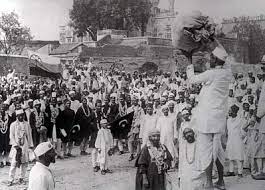The Non Co-operation Movement was a major political and social movement in India in the early 1920s, led by Mahatma Gandhi and the Indian National Congress. It was a response to the violent crackdown by the British government on Indian protesters in the aftermath of the Jallianwala Bagh massacre in 1919.

Table of Contents
Causes of the Non-Cooperation Movement
- The Jallianwala Bagh massacre: The Jallianwala Bagh massacre was a turning point in India’s struggle for independence. On April 13, 1919, British troops opened fired on a peaceful gathering of Indian protesters in Jallianwala Bagh, Amritsar, killing hundreds of people. This brutal act of violence sparked outrage among Indians and galvanized the independence movement.
- The Rowlatt Act: The Rowlatt Act, passed in 1919, gave the British government sweeping powers to detain and prosecute political dissidents without trial. This law was deeply unpopular and was widely seen as a direct attack on civil liberties.
- The Khilafat Movement: The Non-Cooperation Movement was also influenced by the Khilafat Movement, a pan-Islamic movement in India that was calling for the preservation of the Ottoman Empire and the rights of Muslims in the aftermath of World War I.
Events of the Non-Cooperation Movement
- Launch of the Movement: The Non-Cooperation Movement was officially launched by Mahatma Gandhi on August 1, 1920. He called on Indians to non-cooperate with the British government by withdrawing from government institutions, schools, and courts, and by boycotting British goods.
- Mass Protests: The Non-Cooperation Movement was marked by widespread protests and demonstrations across India. Indian leaders traveled the country, making speeches and organizing rallies to build support for the movement.
- Withdrawal from Government Institutions: The most significant aspect of the Non-Cooperation Movement was the mass withdrawal of Indians from government institutions, including schools, colleges, and courts. This represented a significant challenge to British rule and helped to build momentum for the independence movement.
Key leaders of the Movement and their contributions
- Mahatma Gandhi: Gandhi was the principal leader of the Non-Cooperation Movement and the driving force behind its success. He used his charisma and his philosophy of nonviolent resistance to inspire millions of Indians to join the movement.
- Maulana Abul Kalam Azad: Azad was a prominent Muslim leader who played a key role in the Non-Cooperation Movement. He was a strong advocate of Hindu-Muslim unity and helped to build broad-based support for the movement.
- Sardar Vallabhbhai Patel: Patel was a political leader and freedom fighter who played a key role in organizing the Non-Cooperation Movement. He was known for his organizational skills and his ability to mobilize support for the cause.
Impact of the Movement on the Indian Freedom Struggle
- Increased Nationalist Sentiment: The Non-Cooperation Movement helped to increase nationalist sentiment among Indians and to build a sense of national unity.
- Challenged British Rule: The Non-Cooperation Movement represented a significant challenge to British rule and helped to build momentum for the independence movement.
- Gandhi’s Leadership: The Non-Cooperation Movement established Gandhi as the preeminent leader of the Indian independence movement and helped to spread his philosophy of nonviolent resistance.
- Created Martyrs: The Non-Cooperation Movement was marked by several incidents of violence, including the Chauri Chaura incident in 1922, which led to the deaths of several protesters.
Important Links